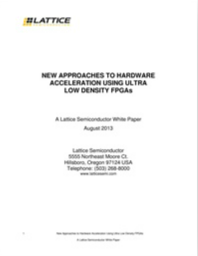NEW APPROACHES TO HARDWARE ACCELERATION USING ULTRA LOW DENSITY FPGAs
Ask system designers to list the problems they face – it doesn't matter whether they're building mobile consumer, automotive, industrial, medical or scientific applications – and inevitably they'll mention optimizing host processor performance. It's hardly surprising. The event-driven architecture of these MPUs allows them to multitask and address new priorities as they occur. But as the number of I/O continues to rise, it also places escalating demand on bandwidth.
Tasked with managing a wider array of I/O as well as other system-wide command and control functions, today's host MPUs must remain operational for longer periods of time, thereby consuming precious power and compute resources.
Download this whitepaper to learn more.
Read More
By submitting this form you agree to Lattice Semiconductor Corporation contacting you with marketing-related emails or by telephone. You may unsubscribe at any time. Lattice Semiconductor Corporation web sites and communications are subject to their Privacy Notice.
By requesting this resource you agree to our terms of use. All data is protected by our Privacy Notice. If you have any further questions please email dataprotection@techpublishhub.com
Related Categories: Automotive, Communication, Components, Displays, Embedded, Industrial, Motor control, Power, Processors

More resources from Lattice Semiconductor Corporation
Reducing Cost and Power in Consumer Applications Using PLDs
The need to respond to changing market standards in a compressed time to market window has led to the widespread use of programmable logic devices ...
DESIGNING FOR LOW POWER
Power consumption is becoming an increasingly important variable when it comes to calculating OPEX and carbon footprint for telecom infrastructure ...
ispMACH® 4000ZE - Enabling CPLDs in Ultra High Volume, Low Power Applications
Design engineers are constantly challenged to develop new products with improved features and functionality over previous generation and competitiv...
